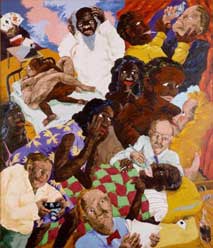The Death of the Poet
by Charles Finch, ARTNET

Robert Colescott
Robert Colescott’s painting Death of Poet depicts a handsome man with an enigmatic smile staring contentedly through his memories of a mixed-up, yet satisfying life. In its way, it recalls the celebrated poet Paul Laurence Dunbar, who died in his 30s of acute alcoholism, the booze having been prescribed by a doctor to treat Dunbar’s coughing from tuberculosis.
At one point Death of Poet was vandalized, when some freak filled in the face of a white woman in the painting with black magic marker. There was always the element of a joyous vandal in Colescott, who died last night at the age of 83. His internalization of the caricatures with which White America tarred its black supplicants made a lot of liberal types uneasy, in a reaction similar to those towards Langston Hughes’ street philosopher Simple, Louis Armstrong’s Sleepy Time Down South or the broad comedy of Moms Mabley or Pigmeat Markham.

Famous Last Words: Death of a Poet, 1989
Colescott embodied the old saw that you gotta laugh to keep from crying because it hurts too much inside. Thus, tragedy was constantly peeking into his broad-brushed satire, like the sideways red head of a woman in his masterwork The Emergency Room at the Museum of Modern Art. The wide berth of his humor was a way of distancing himself from the presumptions and assumptions of his viewers: Crow in the Wheat Field at the Corcoran Gallery garishly depicts a ghostly van Gogh observing a black painter drawing a couple of dancing skeletons.
As with the rest of Colescott’s work, it’s hard to make any rational sense out of his vision, other than to drown in a kaleidoscopic swell of lushly colored pain. Colescott’s truest living descendant is William Pope L., the man who crawled up Broadway in a Superman suit and otherwise dramatizes the whole ridiculousness of being black in America. All those eyes looking at Barack Obama are staring out of a Colescott canvas: ugly laughter on one side of the seesaw balanced by a singular dignity on the other. What future circumstance will tip the scales?
